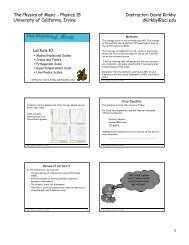The Physics of Music - Physics 15 University of California, Irvine ...
The Physics of Music - Physics 15 University of California, Irvine ...
The Physics of Music - Physics 15 University of California, Irvine ...
Create successful ePaper yourself
Turn your PDF publications into a flip-book with our unique Google optimized e-Paper software.
<strong>The</strong> <strong>Physics</strong> <strong>of</strong> <strong>Music</strong> - <strong>Physics</strong> <strong>15</strong><br />
<strong>University</strong> <strong>of</strong> <strong>California</strong>, <strong>Irvine</strong><br />
Instructor: David Kirkby<br />
dkirkby@uci.edu<br />
Air Columns as Resonators<br />
<strong>The</strong> air contained within a pipe can resonate just like a<br />
string. What are the corresponding boundary conditions<br />
Nodes and Anti-Nodes in an Air Column<br />
(1) fixed + free ends<br />
(2) two free ends<br />
(3) two fixed ends<br />
……open + closed ends<br />
……two open ends<br />
……two closed ends (!)<br />
Listen to the heated “hoot tube” demonstration for an<br />
example <strong>of</strong> resonance in a tube open at both ends.<br />
<strong>Physics</strong> <strong>of</strong> <strong>Music</strong>, Lecture 5, D. Kirkby 31<br />
<strong>Physics</strong> <strong>of</strong> <strong>Music</strong>, Lecture 5, D. Kirkby 32<br />
Demonstration: Singing Rod<br />
A long aluminum rod can sustain two kinds <strong>of</strong> vibrations:<br />
• Longitudinal (squeezing & stretching along its length)<br />
• Transverse (bending transverse to its length)<br />
Complex Driving Forces<br />
<strong>The</strong> demonstrations <strong>of</strong> singing rods, plucked strings and<br />
hoot tubes that you heard today appear to be missing one<br />
<strong>of</strong> the crucial ingredients for resonance:<br />
That energy is provided periodically at a<br />
constant driving frequency.<br />
Since these two resonances involve fundamentally different<br />
types <strong>of</strong> motion, their fundamental frequencies have no<br />
simple relationship.<br />
We were able to excite resonances in all three cases<br />
without paying attention to the frequency at which<br />
energy was provided. Why<br />
Watch and listen to the vibrations <strong>of</strong> an aluminum rod.<br />
What were the boundary conditions<br />
<strong>Physics</strong> <strong>of</strong> <strong>Music</strong>, Lecture 5, D. Kirkby 33<br />
<strong>Physics</strong> <strong>of</strong> <strong>Music</strong>, Lecture 5, D. Kirkby 34<br />
Noisy Energy Sources<br />
Plucking a string, heating the air near a metal mesh, and<br />
drawing your fingers along a rod are all examples <strong>of</strong> noisy<br />
energy sources.<br />
Noise is the superposition <strong>of</strong> many simultaneous<br />
vibrations (<strong>of</strong> air, a string, a rod, …) covering a<br />
continuous range <strong>of</strong> frequencies.<br />
Since no single frequency dominates, we do not hear a<br />
definite pitch, even though all frequencies are present!<br />
Since all frequencies are present in some range, we are<br />
guaranteed to excite any resonances present within the<br />
range.<br />
Summary<br />
Resonance is a buildup <strong>of</strong> energy when it is delivered at<br />
the right frequency.<br />
Many physical systems are resonant. Some have more than<br />
one kind <strong>of</strong> resonant response (eg, the singing rod).<br />
A system may have several resonant frequencies for the<br />
same type <strong>of</strong> response.<br />
Examples <strong>of</strong> resonance: swing, rope fixed at both end, air<br />
column, aluminum rod.<br />
<strong>Physics</strong> <strong>of</strong> <strong>Music</strong>, Lecture 5, D. Kirkby 35<br />
<strong>Physics</strong> <strong>of</strong> <strong>Music</strong>, Lecture 5, D. Kirkby 36<br />
6





